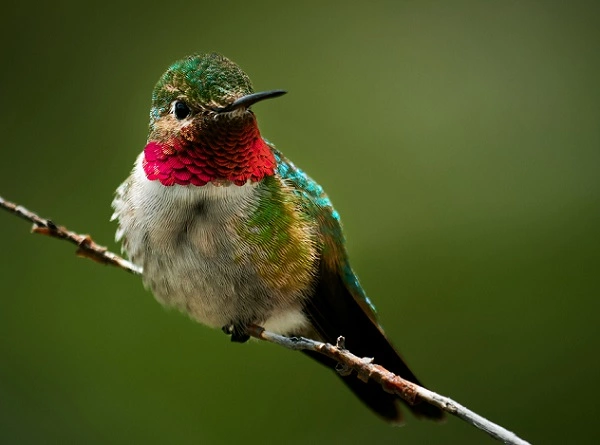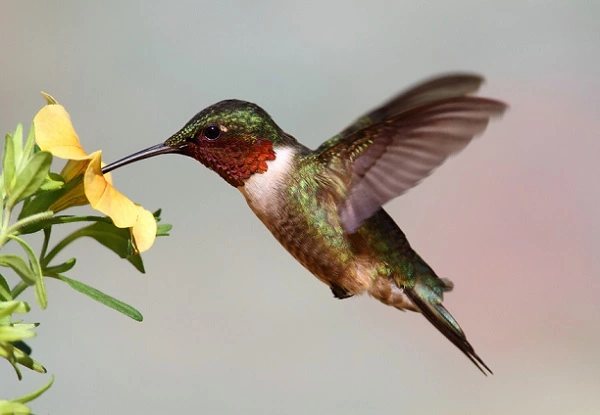The ruby throated hummingbird is a strikingly beautiful bird that can be found in the eastern United States and southeastern Canada. These tiny birds are known for their iridescent feathers, which change color depending on the light. Hummingbirds are also interesting creatures because of their aerial abilities – they can fly backward and even upside down! If you’re lucky, you may get to see a ruby throated hummingbird up close.

Ruby Throated Hummingbird Description
The Ruby-throated Hummingbird is a medium-sized hummingbird with iridescent green upperparts and grayish white underparts. The male has a Ruby-red throat, while the female has a white throat with some faint streaking. These birds are found in woodlands, gardens, and parks across the eastern United States and southeastern Canada. Ruby-throated Hummingbirds feed on nectar from flowers and also eat small insects for protein. They are important pollinators of many plants. Ruby-throated Hummingbirds are sexually dimorphic, meaning that the male and female have different plumage. The male Ruby-throated Hummingbird is slightly larger than the female and has a distinctive Ruby-red throat. The female Ruby-throated Hummingbird has a white throat with some faint streaking. These birds are found in woodlands, gardens, and parks across the eastern United States and southeastern Canada. Ruby-throated Hummingbirds feed on nectar from flowers and also eat small insects for protein. They are important pollinators of many plants. Ruby-throated Hummingbirds mate for life and typically return to the same nesting site each year. The female builds a cup-shaped nest out of plant material, lichens, and spider webs. She incubates the eggs for about two weeks before they hatch. The young birds fledge (leave the nest) about three weeks after hatching. Ruby-throated Hummingbirds are active during the day and usually roost alone at night. These birds are important pollinators of many plants.
Ruby Throated Hummingbird Habitat
Ruby Throated Hummingbirds are the most common hummingbird species in North America, and they are often seen in gardens and parks. These birds are attracted to open spaces with plenty of flowers, and they will also visit feeders that offer a sugar water solution. Ruby Throated Hummingbirds nest in trees, typically placing their nests near the trunk or a main branch. The female builds the nest alone, using bits of bark, leaves, moss, and spiderwebs. The nest is then lined with soft materials such as down feathers or animal hair. Ruby Throated Hummingbirds typically lay two eggs per clutch, and the chicks hatch after about two weeks. Both parents help to feed the young birds until they are old enough to fend for themselves. Ruby Throated Hummingbirds typically molt twice per year, once in the spring and again in the fall. Molting helps these birds to replace worn-out feathers and to change their appearance as the seasons change. Although Ruby Throated Hummingbirds are not currently considered to be endangered, their populations have declined in recent years due to habitat loss and other threats. As a result, it is important to provide these birds with suitable habitat if we want to ensure their long-term survival.
Ruby Throated Hummingbird Diet
The Ruby Throated Hummingbird is a beautiful bird that is also an important pollinator. These hummingbirds are sexually dimorphic, meaning there are visible physical differences between males and females. The male Ruby-throated Hummingbird has a green back, gray sides, and a white belly with rusty streaks. The Ruby-throated female hummingbird has a light green to whitish chest and belly. Both genders have a forked tail that is long and appears square when viewed from above. Ruby-throated Hummingbirds are the only hummingbird species found in the eastern United States. Ruby-throated Hummingbirds typically weigh 2-6 grams and are 3.75-4.25 inches in length. Females are generally larger than males.
Ruby-throated Hummingbirds feed on nectar from flowers using their long tongues. They also eat small insects such as aphids, spiders, and mosquito larvae which they capture in midair or find while clawing their way up a tree trunk. You can attract Ruby-throated Hummingbirds to your yard by planting native flowering plants and setting out a hummingbird feeder filled with sugar water. Keep your feeder clean to prevent the spread of disease. If you live in an area where Ruby-throated Hummingbirds migrate, you may only see them during the spring and summer months. These birds spend their winters in Mexico, Central America, and the Caribbean Islands.

Ruby Throated Hummingbird Size
The Ruby Throated Hummingbird is a small bird with iridescent green plumage on its back and head, and a white belly. The Ruby Throated Hummingbird gets its name from the red patch of feathers on its throat, called a gorget. The Ruby Throated Hummingbird is the only species of hummingbird that breeds in the eastern United States. Ruby Throated Hummingbirds are small birds, measuring only 3-5 inches in length and weighing less than 1 ounce. Despite their small size, Ruby Throated Hummingbirds are feisty birds and are known to chase away much larger birds, such as crows and ravens, from their feeding areas. Ruby Throated Hummingbirds are important pollinators, and they play an important role in the ecosystem.
Ruby Throated Hummingbird Lifespan
Ruby Throated Hummingbirds are a species of hummingbird that is found in North America. They get their name from the Ruby-red color of their throats. Ruby Throated Hummingbirds typically have a lifespan of 3-5 years in the wild. The oldest recorded Ruby Throated Hummingbird was 11 years old. Ruby Throated Hummingbirds are very small birds. They are only 3 inches long and weigh about 2 grams. Ruby Throated Hummingbirds areone of the smallest birds in North America. Ruby-throated hummingbirds live in forests, meadows, and gardens. They build their nests out of leaves, twigs, and grass. The female hummingbird lays 2-3 eggs in her nest. The eggs hatch in about two weeks, and the young birds learn to fly after about three weeks. Ruby-throated hummingbirds eat insects and nectar from flowers. They use their long beaks to reach into flowers to get the nectar. Ruby-throated hummingbirds are important pollinators for many flowers and plants.
Ruby Throated Hummingbird Behavior
Ruby-throated hummingbirds are the only hummingbird species that breed in North America east of the Rocky Mountains. These tiny birds are well-known for their iridescent green feathers and their long, curved beaks. Ruby-throated hummingbirds are also known for their acrobatic flying abilities and their territorial behavior. During the breeding season, male Ruby-throated hummingbirds establish and defend their territories by flying circles around their rivals and dive-bombing them. The Ruby-throated hummingbird’s diet consists mainly of nectar from flowers, but they will also eat small insects for protein. Ruby-throated hummingbirds are migratory birds, and each fall they travel south to Central America to spend the winter. These tiny birds are amazing flyers, and they have been known to travel over 500 miles in a single day!
Ruby Throated Hummingbird Speed
Ruby Throated Hummingbirds are the only hummingbird species that breeds in North America east of the Rocky Mountains. They are proficient at flying long distances and have been known to migrate up to 3,000 miles each year. But just how fast can these tiny birds fly?
Ruby Throated Hummingbirds typically flap their wings between 50 and 60 times per second. However, they are capable of flying even faster when necessary. During courtship displays, males have been recorded flying at speeds of up to 30 miles per hour. When diving, they can reach speeds of up to 45 miles per hour. And when escape from predators, Ruby Throated Hummingbirds have been known to reach speeds of up to 60 miles per hour.
So the next time you see a Ruby Throated Hummingbird zipping around your garden, remember that you are witnessing one of nature’s most impressive flyers in action.
Ruby Throated Hummingbird Hunting
The Ruby Throated Hummingbird is a beautiful creature, and one of the most fascinating birds to watch while hunting. Though they are tiny, they are ferocious hunters, and their hunting techniques are nothing short of amazing. Ruby Throated Hummingbirds eat mostly insects, and they will often hover in mid-air while they search for their prey. When they spot an insect, they will dart after it, catching it in their beaks. They will then fly back to their perch and eat their catch. Ruby Throated Hummingbirds are also known for their aerial acrobatics, and they will often chase each other around in mid-air. This behavior is thought to be part of their courtship ritual. Ruby Throated Hummingbirds are fun to watch, and their hunting techniques are truly a sight to behold.
Conclusion
The Ruby Throated Hummingbird is a beautiful bird that can be found in the eastern and central parts of the United States. They are known for their bright colors and their ability to hover in mid-air. These birds love to feed on nectar from flowers, and they can often be seen hovering around gardens and parks looking for food. If you’re lucky enough to see a Ruby Throated Hummingbird up close, make sure to take some time to appreciate this amazing creature!
Frequently Asked Question

